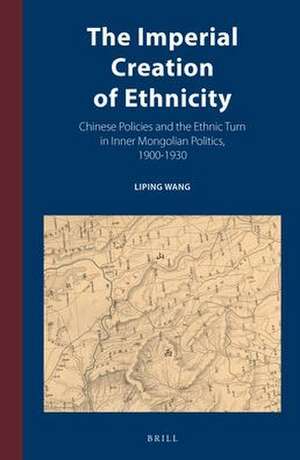The Imperial Creation of Ethnicity: Chinese Policies and the Ethnic Turn in Inner Mongolian Politics, 1900-1930: Inner Asia Book Series, cartea 15
Autor Liping Wangen Limba Engleză Hardback – 31 mar 2022
Using unpublished archival sources, this book benefits from three key strengths. It addresses the question of Mongol-Han relationship in the early Republican period (1911-1930), it illuminates the details of imperial administration and its changes along with the shift of the regime, and it explores the theoretical potentials of the near frontier approach and positions the Chinese imperial transition within a comparative perspective.
Preț: 500.17 lei
Preț vechi: 588.43 lei
-15% Nou
Puncte Express: 750
Preț estimativ în valută:
95.79€ • 98.69$ • 80.24£
95.79€ • 98.69$ • 80.24£
Carte indisponibilă temporar
Doresc să fiu notificat când acest titlu va fi disponibil:
Se trimite...
Preluare comenzi: 021 569.72.76
Specificații
ISBN-13: 9789004511637
ISBN-10: 9004511636
Dimensiuni: 155 x 235 mm
Greutate: 0.5 kg
Editura: Brill
Colecția Brill
Seria Inner Asia Book Series
ISBN-10: 9004511636
Dimensiuni: 155 x 235 mm
Greutate: 0.5 kg
Editura: Brill
Colecția Brill
Seria Inner Asia Book Series
Notă biografică
Liping Wang, Ph.D. (2013), the University of Chicago, is Associate Professor in the Graduate School of Education at Peking University. She has published many articles on ethnicity, nationalism and knowledge production. Her publications appeared in American Journal of Sociology, Theory and Society, and Modern China, among others.
Cuprins
Acknowledgements
List of Tables, Maps and Figures
Introduction
1 Ethnogenesis in the Near Frontier
2 The Administration of the Empire
3 The Organization of the Book
1 Mapping Out the Mongolian Identities
1 The Center-Periphery Model
2 The Frontier Space of Inner Mongolia
3 The Feudal Tradition of Mongols
4 The Mongolian Banners
5 The Mongol-Manchu Alliance
6 The Incorporation of Mongols into the Qing State
7 The Exceptional Case of Hulun Buir
8 Empires and Cross-Identifications
2 Land Reform and State Centralization
1 A Natural Erosion of Nomadic Feudalism
2 The Late Qing Land Reform
3 The Changing Utility of Land in fangken
4 Colonization or Political Consolidation?
5 The Nexuses of Ruling Powers
6 The Puzzle of Mongolian Cooperation
3 Revolution, Warlordism and Ethnic Confrontation
1 The Revolutionary Turbulence
2 Mongolian Reactions to the Revolution
3 Intrusion of Provincial Governments
4 Emerging Local Conflicts
5 The Age of Warlordism
6 Transforming the Frontier Governance Structure
7 Military Colonization
4 Ethnicizing Boundaries in the Legal Jurisdiction
1 Legal Pluralism under the Imperial Rule
2 The Motley Jurisdictions in Eastern Inner Mongolia
3 Navigating the Disparate Legal Spaces
4 Reshuffling the Mongolian Legal Jurisdiction
5 The End of Legal Pluralism?
5 The Mongolian Shift in Hulun Buir
1 Tribal Soldiers in a Mobile Garrison System
2 Territorializing the Governments in Hulun Buir
3 Territorial Administration in Hulun Buir
4 Becoming Mongols
5 Striving for Mongolian Autonomy
6 The Intellectual Construct
7 Territorialization and Ethno-Genesis
Conclusion
Appendix 1: Administrative Experiences of the Frontier Military Officials, 1900–1916
Appendix 2: Administrative Experiences of the Frontier Military Officials, 1917–1928
Glossary of Terms
Bibliography
Index
List of Tables, Maps and Figures
Introduction
1 Ethnogenesis in the Near Frontier
2 The Administration of the Empire
3 The Organization of the Book
1 Mapping Out the Mongolian Identities
1 The Center-Periphery Model
2 The Frontier Space of Inner Mongolia
3 The Feudal Tradition of Mongols
4 The Mongolian Banners
5 The Mongol-Manchu Alliance
6 The Incorporation of Mongols into the Qing State
7 The Exceptional Case of Hulun Buir
8 Empires and Cross-Identifications
2 Land Reform and State Centralization
1 A Natural Erosion of Nomadic Feudalism
2 The Late Qing Land Reform
3 The Changing Utility of Land in fangken
4 Colonization or Political Consolidation?
5 The Nexuses of Ruling Powers
6 The Puzzle of Mongolian Cooperation
3 Revolution, Warlordism and Ethnic Confrontation
1 The Revolutionary Turbulence
2 Mongolian Reactions to the Revolution
3 Intrusion of Provincial Governments
4 Emerging Local Conflicts
5 The Age of Warlordism
6 Transforming the Frontier Governance Structure
7 Military Colonization
4 Ethnicizing Boundaries in the Legal Jurisdiction
1 Legal Pluralism under the Imperial Rule
2 The Motley Jurisdictions in Eastern Inner Mongolia
3 Navigating the Disparate Legal Spaces
4 Reshuffling the Mongolian Legal Jurisdiction
5 The End of Legal Pluralism?
5 The Mongolian Shift in Hulun Buir
1 Tribal Soldiers in a Mobile Garrison System
2 Territorializing the Governments in Hulun Buir
3 Territorial Administration in Hulun Buir
4 Becoming Mongols
5 Striving for Mongolian Autonomy
6 The Intellectual Construct
7 Territorialization and Ethno-Genesis
Conclusion
Appendix 1: Administrative Experiences of the Frontier Military Officials, 1900–1916
Appendix 2: Administrative Experiences of the Frontier Military Officials, 1917–1928
Glossary of Terms
Bibliography
Index













